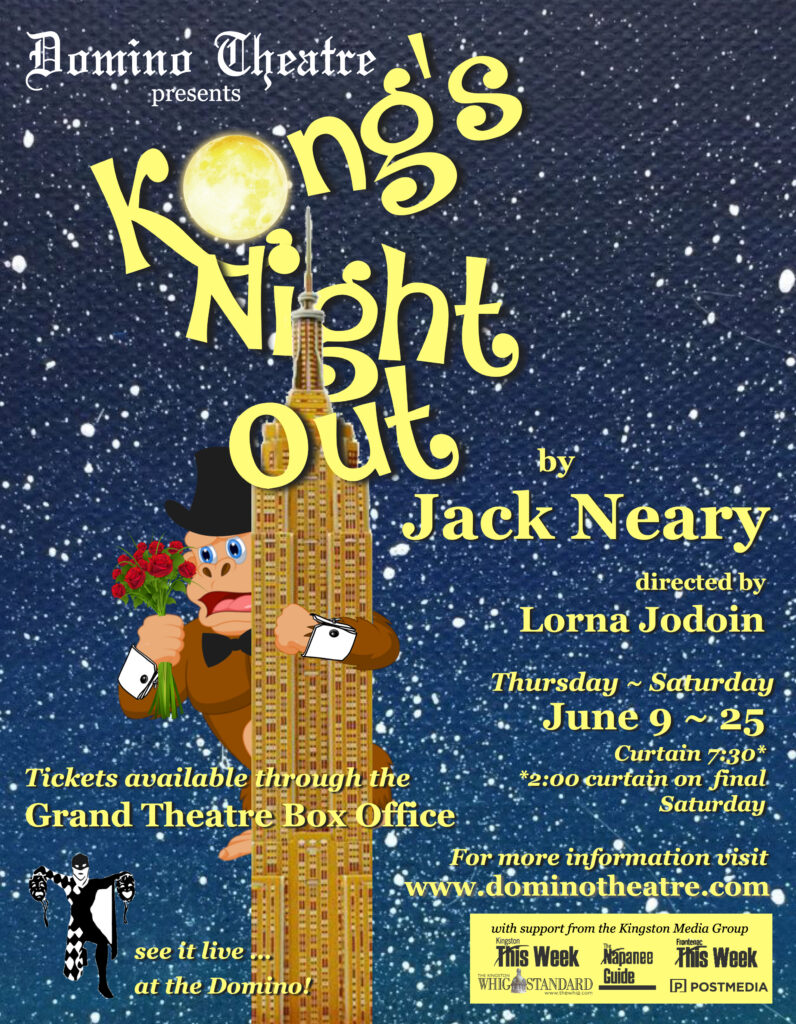2 Shows, 7 Doors, and a Monkey: ‘Kong’s Night Out’ at the Domino

If you didn’t catch it at The Grand Theatre, the recent run of Kong’s Night Out showed that a lot can happen in a hotel room in New York City on the eve of a Broadway performance.
This Domino Theatre production utilized a fixed set, and used this constraint as a method to explore complex narrative structures. The performance gave form to the world of Broadway in the 1930s and showed the dissolution of one man’s dreams of being a major Broadway playwright in light of a competitor with a mysterious primate being involved in a competing production across the street.
Written by Jack Neary and directed by Lorna Jodoin, Kong’s Night Out follows the story of a pair of dueling Broadway producers whose performances converge on a fateful evening in New York City. With a hotel room as the setting of the entire performance, not being able to know what was taking place outside made for a dynamic experience as an audience member. Surrounding the stage was seven doors through which a slew of characters who enter as fast as they leave, which generated a sense of curiosity as to who would be the next to enter the hotel room.
Myron Siegel (James Gow), the protagonist, is a budding Broadway producer whose opening night performance of Foxy Felicia is threatened by his nemesis Carl Denham’s (Paul Butler) mysterious production that is suddenly set to open on the same night. With a sudden loss of ticket sales for his own project, Siegel sets out to uncover the mystery of just what is going on across the street, fearing the demise of his own production and artistic ego. A spirit of comedic competition is established between the two playwrights, and questions concerning the mystery of the rival show is executed through a hidden relation to the audience—the structure of the set where events take place behind various closed doors.
To no one’s surprise, there is a large monkey involved in the plot across the street, however as audience members, it is just as much of a mystery to us as it is to Myron. King Kong operates as an unseen Other, whose existence is never shared but deeply felt for those in and out of the story.
Although there were several moments of laughter, the comedy felt extremely dated, as women and female sexuality were often the subject of the jokes in the 1930s. The women in the production were seen only in relation to the men or as sexual objects (women referred to as “blonde”, “virgin”, “tushy”, “this bitch”, being tied up on stage etc.). Only existing as props to narratives of these men, they are all controlled by external approval of their appearance, promiscuity, or sexual availability. Their successes in theatre are dictated by the male playwrights, who only agree to put them in shows on conditional premises. For example, Myron only offers to help his niece break into the world of Broadway in return for offering herself to King Kong.
But what does this form of comedy do for a contemporary audience? These comedic elements made me wonder what the relevance was of telling this story today. Since these slightly askew elements of the production did elicit laughter from the audience, it goes to show that there are still deep-rooted acceptances of belittling women in creative spheres. It would have been great to see more character development and autonomy from the characters who were women in the production. All of the women were judged for their sexuality and were only seen in relation to the men. With recent movements in theatre and film seeking to affirm, rather than belittle, women, it did seem like a dated choice to put this performance on at this time.
These elements, however, did not fully detract from the fact that Kong’s Night Out was a well-produced and entertaining production, with a strong cadence and sense of movement. It definitely felt good to experience an in-person performance and to see people enjoying themselves collectively in the space of the theatre.
Kong’s Night Out was directed by Lorna Jodoin and originally written by Jack Neary. It ran at the Domino Theatre from June 9th- 25th. More information can be found here.